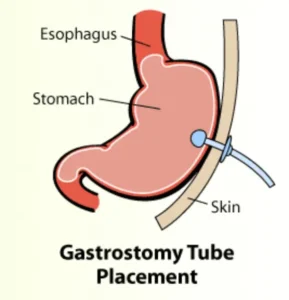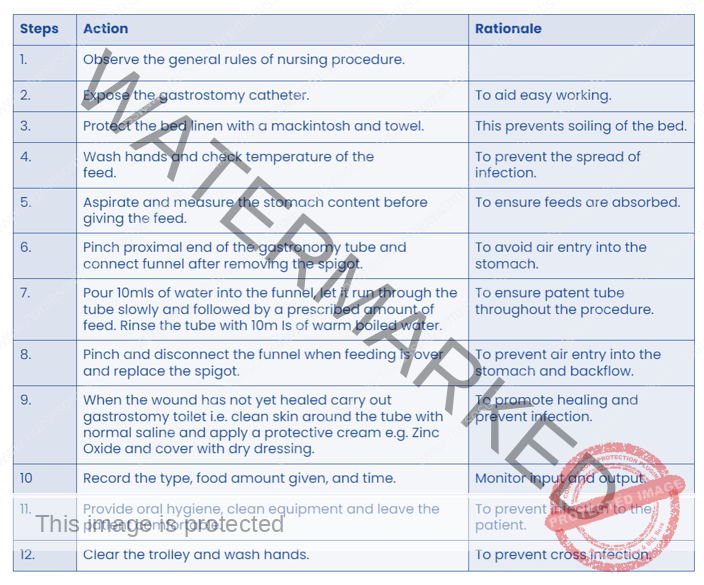Specialized Nursing Care
Subtopic:
Gastrostomy Feeding

Definition and Overview
Gastrostomy feeding is a method of providing nutrition directly into the stomach through a surgically created opening (stoma) in the abdominal wall.
 A gastrostomy tube (G-tube) is inserted through this opening and held in place by an internal balloon or bumper and an external fixator. This method is used when a patient is unable to safely or adequately consume food orally.
A gastrostomy tube (G-tube) is inserted through this opening and held in place by an internal balloon or bumper and an external fixator. This method is used when a patient is unable to safely or adequately consume food orally.
Indications for Gastrostomy Feeding
Gastrostomy feeding may be indicated when a patient has:
1. Impaired Swallowing:
Dysphagia: Difficulty swallowing due to neurological conditions (e.g., stroke, brain injury), muscular diseases, or structural abnormalities of the mouth, throat, or esophagus.
Aspiration Risk: High risk of food or liquids entering the airway, potentially leading to aspiration pneumonia.
Esophageal Obstruction: Blockage of the esophagus due to tumors, strictures (narrowing), or other causes.
Carcinoma of the Esophagus: Cancer affecting the esophagus.
Birth Defects: Congenital abnormalities of the mouth or esophagus that impair swallowing.
Esophageal Atresia: A birth defect where part of the esophagus is missing or closed off.
Problems with Sucking or Swallowing: In patients with debilitating diseases like stroke and dementia
Operations of the Upper Gut: Procedures involving the alimentary canal, mouth, nose, and esophagus.
2. Prolonged Malnutrition or Inadequate Oral Intake:
Chronic Illness: Conditions like cancer, Crohn’s disease, or cystic fibrosis that lead to long-term nutritional deficiencies.
Anorexia Nervosa: An eating disorder characterized by severe food restriction and weight loss.
Severe Weight Loss: Inability to maintain adequate weight and nutritional intake through oral means.
3. Impaired Digestion and Absorption:
Short Bowel Syndrome: A condition where a significant portion of the small intestine is missing or non-functional, impairing nutrient absorption.
Malabsorption Disorders: Conditions like celiac disease that interfere with the absorption of nutrients.
4. Delayed Gastric Emptying:
Gastroparesis: Delayed stomach emptying, often due to nerve or muscle dysfunction.
Medication-Induced: Certain medications can slow down gastric emptying.
5. Altered Level of Consciousness:
Severe Brain Injury: Patients who are unconscious or unable to swallow safely due to a brain injury.
Chronic Vegetative State: A state of persistent unconsciousness with no awareness.
6. Chronic Vomiting or Reflux:
Severe Gastroesophageal Reflux Disease (GERD): Persistent vomiting and acid reflux that lead to malnutrition.
Intractable Vomiting: Persistent vomiting that does not respond to medical treatment.
7. Premature Infants:
Prematurity: Infants born before 37 weeks gestation may have immature digestive systems and require tube feeding.
Failure to Thrive: Infants who are not gaining weight or growing adequately.
Methods of Gastrostomy Feeding
Bolus Feeding: Administration of a specific volume of liquid feed over a short period (e.g., 15-20 minutes), often using a gravity set to control the flow rate.
Continuous Feeding: Delivery of a constant, regulated amount of liquid feed over a longer period using an electronic feeding pump. This method ensures a steady flow of nutrients into the stomach
Types of Feeding Tubes
Feeding tubes are classified based on their length and retention mechanism:
A. Long Tubes:
Percutaneous Endoscopic Gastrostomy (PEG): A long, flexible tube inserted through the abdominal wall and into the stomach. Placed endoscopically,
meaning a thin, flexible tube with a camera is used to visualize the stomach and guide the tube placement. Offers a more minimally invasive approach
compared to surgical placement.
Long Balloon-Retention Tube: A longer tube with a balloon at the end that is inflated within the stomach, securing the tube in place. Commonly used for
individuals requiring longer-term feeding.
Malecot Tubes: A type of long tube that may be used for short-term feeding and is often used for drainage.
B. Skin-Level Tubes:
Firm Silicone Mushroom Retention: These tubes have a mushroom-shaped end that rests against the stomach lining, preventing accidental tube
removal. Examples include Bard feeding tubes.
Balloon Retention: These tubes have a balloon near the end that is inflated inside the stomach, securing the tube in place. Examples include AMT MINI
and MICKEY feeding tubes.
Procedure for administration of Gastrostomy feeding.
REQUIREMENTS
A tray containing;
- A bowel containing funnel/feeding syringe, rubber tubbing, glass or plastic connection.
- Feed at a suitable temperature [37°-38°] 240 to 300mls of strained nourishing fluid in a bowel of warm water.
- Towel and mackintosh cape.
- Warm water in a glass measure container.
- Spigot in a sterile receiver.
At the bedside:
- Hand washing facility.
- Screen.
Procedure

Complications of Gastrostomy Feeding
Complications associated with gastrostomy feeding can be categorized as follows:
1. Tube-Related Complications:
Tube Blockage (Obstruction): Blockage of the feeding tube due to thick formula, medications, or inadequate flushing.
Incorrect Initial Placement (Primary Malposition): The tube is not positioned correctly in the stomach during the initial insertion.
Intestinal Perforation: Accidental puncture of the stomach or intestinal wall by the tube.
Tube Displacement (Secondary Malposition): The tube shifts out of its intended position within the stomach.
Tube Knotting: The tube becomes tangled or knotted.
Accidental Tube Removal: The tube is unintentionally pulled out.
Tube Damage and Leakage: The tube cracks, breaks, or leaks.
Insertion Site Leakage: Leakage of fluid or stomach contents around the tube insertion site.
Bleeding: Bleeding from the insertion site.
2. Site-Related Complications:
Skin and Mucosal Damage: Erosion, ulceration, or necrosis (tissue death) of the skin or mucous membrane around the stoma.
3. Gastrointestinal Complications:
Intestinal Blockage (Ileus): A blockage in the intestines unrelated to the tube itself.
Gastrointestinal Bleeding: Bleeding from the stomach or intestines.
4. Systemic Complications:
Inadvertent Intravenous Infusion: Accidental administration of the feeding formula into a vein instead of the stomach.
Insertion Site Infection: Infection at the stoma site, characterized by redness, swelling, pain, and/or pus.
Aspiration Pneumonia: Inhalation of stomach contents into the lungs, leading to infection and inflammation.
Nasopharyngeal and Ear Infections: Infections in the nose, throat, or ears, potentially related to the presence of the tube.
Peritonitis: Inflammation of the peritoneum (the lining of the abdominal cavity), often caused by leakage of stomach contents.
Infectious Diarrhea: Diarrhea caused by a bacterial or viral infection.
5. Metabolic Complications:
Electrolyte Imbalances: Disturbances in the levels of electrolytes (e.g., sodium, potassium, chloride) in the blood.
Blood Sugar Fluctuations: High blood sugar (hyperglycemia) or low blood sugar (hypoglycemia).
Vitamin and Trace Element Deficiencies: Inadequate intake or absorption of essential vitamins and minerals.
Get in Touch
(+256) 790 036 252
(+256) 748 324 644
Info@nursesonlinediscussion.com
Kampala ,Uganda
© 2025 Nurses online discussion. All Rights Reserved Design & Developed by Opensigma.co

